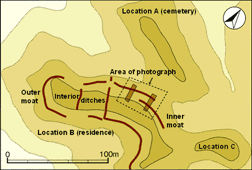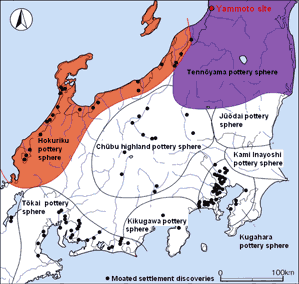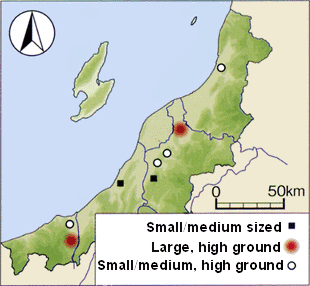Yamamoto:
The northernmost moated settlement on the Japan Sea side is discovered. Small glass beads, Epi-Jōmon pottery from Hokkaido, and other artifacts indicating wide-ranging exchange are recovered.

Moat on the northern slope of Location B (yellow lines indicate the inferred position) Portions of an encircling moat have been found through excavation. This photo is of the northern slope, while nearly all of the southern slope is encircled with a moat approximately 2 m wide by 70 cm deep.

Map of archaeological features The site is comprised of three level hilltop areas (from the north, Locations A, B, and C) plus valley portions. At Location A seven burials were discovered, and at Location B two ditches (approximately 1.5 m wide by 60 cm deep) crossing the level portion, and pits (postholes?) were detected. As no pit-buildings have been found, embedded-pillar buildings are thought to have been the main type of structure. An encircling moat was found on the slopes at Location B. It appears that Location B was used for residence, and Location A for burials. In addition, the ditches crossing the level portion were cut at right angles to the long axis of the level area, and at one point may have extended into the valley portion of the site. No similar discoveries have been made, and whether they served as boundaries for buildings or some other purpose is not understood.

Panoramic view of the site (from the south) The difference in elevation with the rice paddies at the base is about 35 m, and the site offers a sweeping view of the Echigo plain.

Unearthed Tennōyama style Yayoi pottery This Yayoi pottery of the Tōhoku region was recovered from near the bottom of the moat. As soot can be observed on the outside, and scorched rice on the inner surface, it is thought to have been a vessel used for cooking. The rim is 25.0 cm in diameter and the height is 35.0 cm.

Small glass beads Diameters range from 0.3 – 0.6 cm, and the thickness from 0.2 – 0.4 cm. Threaded with a string through the holes ranging from 0.1 – 0.2 cm, they are thought to have been made into a necklace.
Yamamoto Site, Kamihayashi Village, Niigata Prefecture
This is a moated high ground settlement of the Late Yayoi period, located atop a hill 40 m in elevation at the northern edge of the former Iwafune lagoon, in the northern part of Niigata prefecture. A variety of archaeological features lie on the level area at the top of a narrow ridge-shaped hill, surrounded by a dry moat.
Most of the recovered pottery belongs to the Tennōyama style that is widely distributed over the southern portion of the Tōhoku region, and this site is thought to have belonged to Tōhoku’s Yayoi cultural sphere. It is the northernmost example of a moated settlement on the Japan Sea side of Honshu, and the first such discovery within the Tennōyama style cultural sphere.
Characteristics of the settlement
The mainstream view holds that high ground settlements were built because of prevailing social tensions; if this site reflects such a condition, it suggests the effect of those tensions had reached the Tennōyama style cultural sphere in the Late Yayoi period.
The site extends to approximately 20,000 m2 in area. Test excavation revealed seven pit burials, plus pits thought to be postholes and ditches crossing the level area of the hilltop, and an encircling moat on the hillside. From this it was understood that there were separate areas for residence and burials.
Exchanges to the east and west
There were 68 small glass beads discovered in the westernmost among the burials. This is one of the largest amounts discovered in eastern Japan for this period, allowing for inferences of exchange with western Japan.
The moat's southern side (towards the Echigo plain) is small in scale, with a width of 2 m and a depth of 70 cm, but the northeastern side is smaller still, approaching at some points a cut made in the shape of the letter L.
The moat was filled in during the latter half of the Late Yayoi, the same time period for other small and mid-sized moated high ground settlements that have been ascertained in Niigata prefecture. The pottery recovered from the site includes the Epi-Jōmon style of Hokkaido, which together with the glass bead discovery provides a glimpse of widespread exchanges to the east and the west. (Takizawa Norio)


